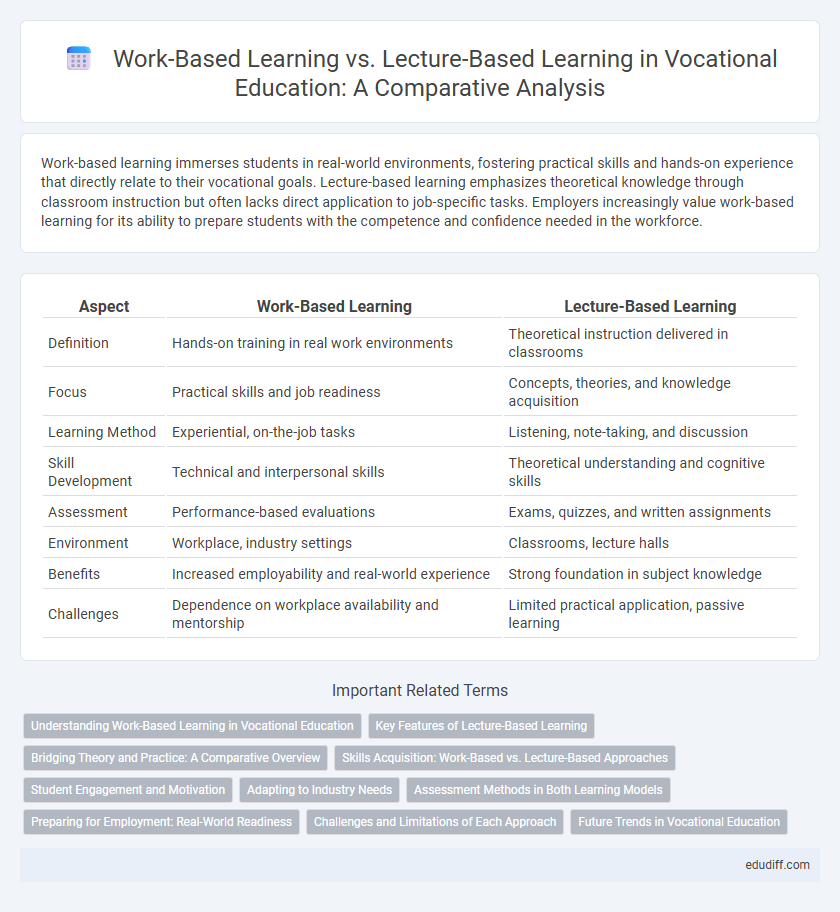Work-based learning immerses students in real-world environments, fostering practical skills and hands-on experience that directly relate to their vocational goals. Lecture-based learning emphasizes theoretical knowledge through classroom instruction but often lacks direct application to job-specific tasks. Employers increasingly value work-based learning for its ability to prepare students with the competence and confidence needed in the workforce.
Table of Comparison
| Aspect | Work-Based Learning | Lecture-Based Learning |
|---|---|---|
| Definition | Hands-on training in real work environments | Theoretical instruction delivered in classrooms |
| Focus | Practical skills and job readiness | Concepts, theories, and knowledge acquisition |
| Learning Method | Experiential, on-the-job tasks | Listening, note-taking, and discussion |
| Skill Development | Technical and interpersonal skills | Theoretical understanding and cognitive skills |
| Assessment | Performance-based evaluations | Exams, quizzes, and written assignments |
| Environment | Workplace, industry settings | Classrooms, lecture halls |
| Benefits | Increased employability and real-world experience | Strong foundation in subject knowledge |
| Challenges | Dependence on workplace availability and mentorship | Limited practical application, passive learning |
Understanding Work-Based Learning in Vocational Education
Work-based learning in vocational education integrates practical experience with theoretical knowledge, enhancing skill acquisition through real-world application. This approach fosters critical thinking and adaptability by immersing students in workplace environments, unlike lecture-based learning which primarily delivers abstract concepts. Employers increasingly value work-based learning graduates for their hands-on expertise and immediate job readiness, making it a key component in vocational training programs.
Key Features of Lecture-Based Learning
Lecture-based learning emphasizes structured delivery of content primarily through oral presentations by instructors, focusing on theoretical knowledge acquisition. It typically involves passive student participation, standardized assessments, and a fixed curriculum designed for large groups. This method fosters foundational understanding and systematic coverage of academic concepts crucial for vocational theory comprehension.
Bridging Theory and Practice: A Comparative Overview
Work-based learning integrates real-world experiences with vocational education, enhancing skill acquisition by applying theoretical knowledge directly in workplace settings. Lecture-based learning primarily delivers theoretical concepts in a classroom, often lacking immediate practical application. Bridging theory and practice effectively requires combining these approaches to foster deeper understanding and improve job readiness in vocational training programs.
Skills Acquisition: Work-Based vs. Lecture-Based Approaches
Work-based learning enhances skills acquisition by providing hands-on experience, practical problem-solving, and real workplace scenarios, which foster critical thinking and adaptability. Lecture-based learning primarily delivers theoretical knowledge and conceptual understanding but often lacks direct application, potentially limiting immediate skill development. Combining both approaches can optimize vocational training outcomes by integrating practical skills with foundational theory.
Student Engagement and Motivation
Work-based learning significantly enhances student engagement and motivation by providing hands-on experiences that connect theoretical knowledge to real-world applications, fostering deeper understanding and active participation. Unlike lecture-based learning, which often relies on passive information absorption, work-based approaches encourage problem-solving, critical thinking, and collaboration, leading to higher retention rates and sustained enthusiasm. Empirical studies reveal that students involved in work-based learning report increased confidence and readiness for employment, highlighting its effectiveness in promoting meaningful educational outcomes.
Adapting to Industry Needs
Work-based learning provides hands-on experience that directly aligns with current industry demands, enabling students to develop practical skills and problem-solving abilities essential for the workforce. Lecture-based learning offers theoretical knowledge, but often lacks the dynamic adaptability required to keep pace with rapidly evolving industry technologies and practices. Integrating work-based learning ensures graduates are better prepared to meet employer expectations and contribute effectively from day one.
Assessment Methods in Both Learning Models
Work-based learning assessment methods emphasize practical evaluation through real-world tasks, internships, and performance reviews, enabling students to demonstrate skills in authentic work environments. Lecture-based learning primarily relies on traditional assessments such as exams, quizzes, and written assignments to measure theoretical understanding and knowledge retention. Both models demand tailored assessment strategies to align with their respective learning objectives and ensure comprehensive skill verification.
Preparing for Employment: Real-World Readiness
Work-based learning enhances real-world readiness by immersing students in actual job environments, fostering practical skills and professional behaviors essential for employment. Lecture-based learning primarily imparts theoretical knowledge, which may lack direct application in workplace settings. Employers increasingly value work-based experiences as they demonstrate a candidate's ability to navigate industry challenges and contribute effectively from day one.
Challenges and Limitations of Each Approach
Work-based learning faces challenges such as inconsistent training quality, limited access to diverse job roles, and dependence on employer commitment, which can hinder skill development. Lecture-based learning often struggles with limited real-world application, reduced student engagement, and difficulty in adapting theoretical concepts to practical tasks. Both approaches require careful integration to balance hands-on experience with foundational knowledge for effective vocational education.
Future Trends in Vocational Education
Work-based learning is gaining traction in vocational education due to its hands-on approach, fostering practical skills and direct industry engagement essential for future job markets. Emerging trends emphasize integration of digital technologies and personalized learning paths within work-based frameworks to enhance adaptability and real-world problem-solving abilities. Versus traditional lecture-based learning, this experiential model better prepares students for evolving workforce demands by aligning education with actual workplace scenarios and technologies.
Work-based learning vs Lecture-based learning Infographic

 edudiff.com
edudiff.com